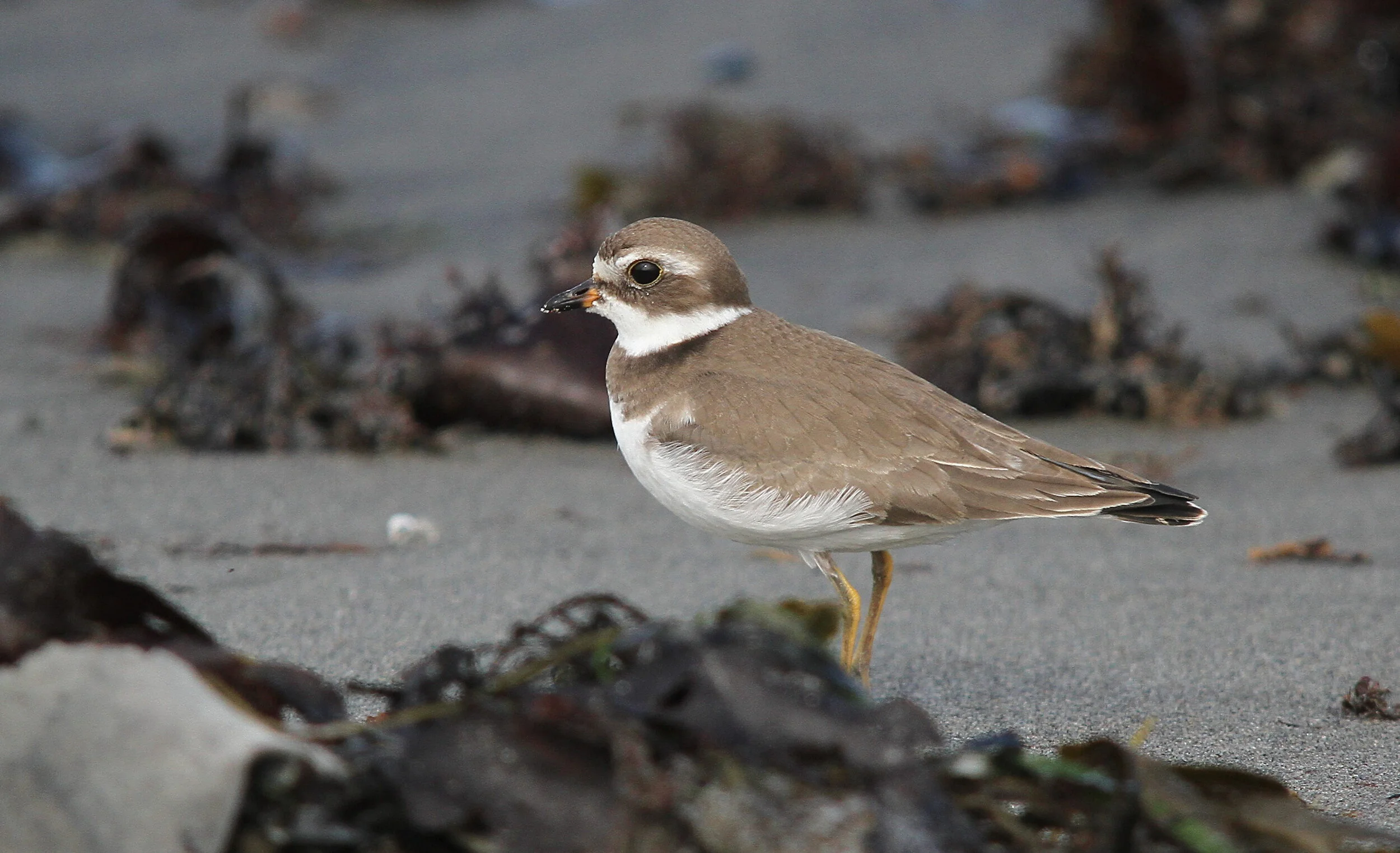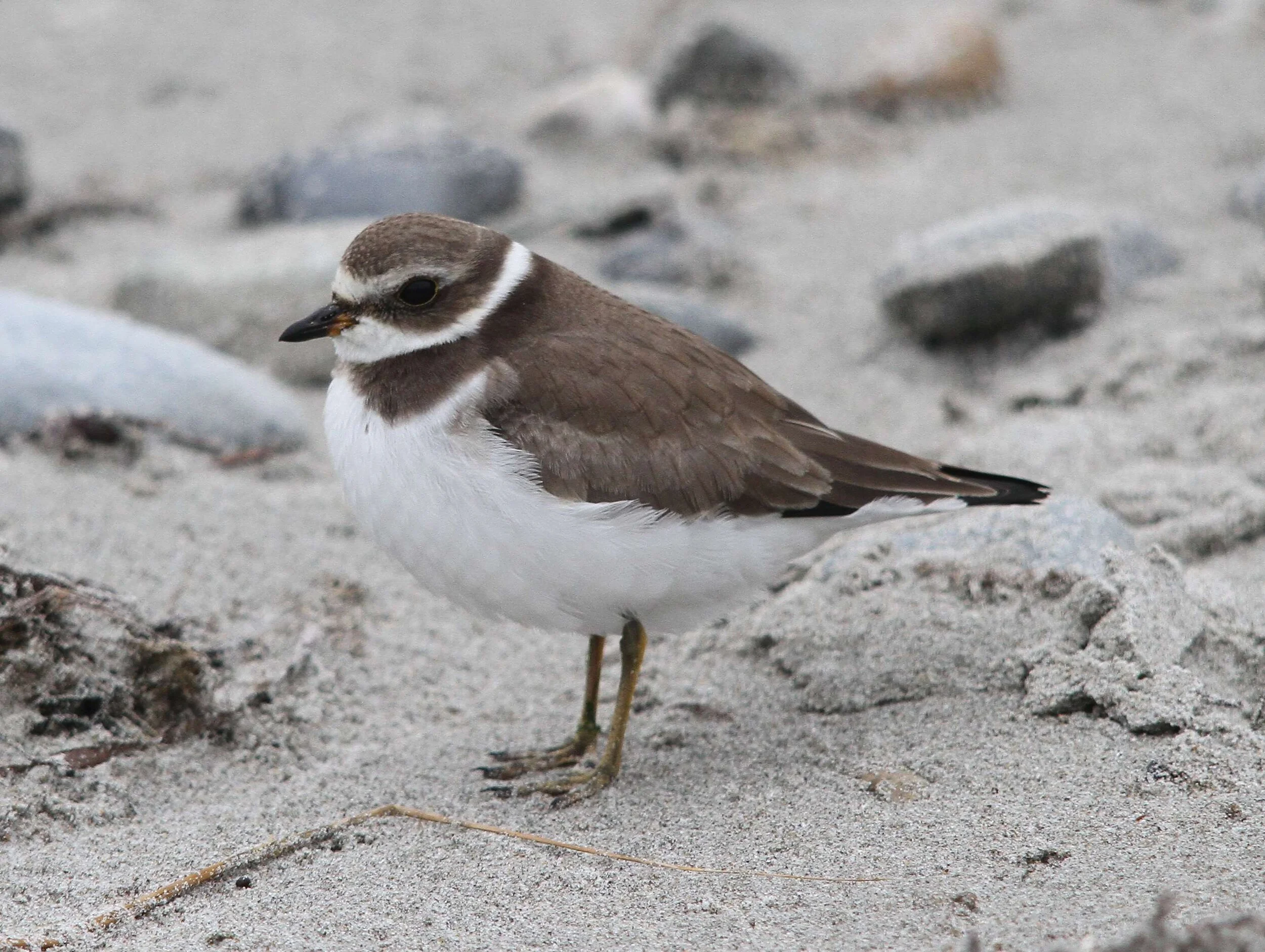Juvenile Semipalmated Plovers: variability of key features
Post originally published in Birding Frontiers
Semipalmated Plover is arguably one of the rarest shorebirds in Europe, although it has been suggested that its rarity is partly due to the challenge of separating it from Common Ringed Plover. The key identification features for juveniles, such as the bill shape and the presence of white in the gape, are widely known and well described in several papers and field guides - so nothing new here - but I thought it would be interesting to take a detailed look at the variability of these characters for an identification refresher!
Let's start with a couple of classic juvenile Semipalmated Plovers to illustrate the typical features. On these birds, note the:
white gape;
yellow orbital ring;
generally delicate structure, with a very narrow rear part of the body;
small, rounded head;
relatively narrow and unbroken breast band of homogeneous width;
short, stout bill with a broad base and a typical triangular shape;
orangish to reddish patch at the base of the bill;
pattern of the upperparts with a broad pale fringe on the feathers of the wing coverts, which contrast with the scapulars and mantle where the feathers have a narrower pale fringe and a dark subterminal line, giving a tricolored appearance (a Cackling Goose-like feather pattern); and
semipalmation, of course.
Juvenile Semipalmated Plover, October 2016, Massachusetts. Guillermo Rodríguez.
Juvenile Semipalmated Plover, October 2016, Massachusetts. Guillermo Rodríguez.
Variability of key features
Keep in mind that these are all juveniles! Photographed in Massachusetts, September/October, 2016.
General coloration: most records of Common Ringed Plover in the States highlight how pale they are above compared to Semipalmated. I don't find Semipalmated strikingly dark, so perhaps the difference is only obvious with side-by-side comparisons, or it could be due to plumage variability of Greenland birds (supposedly the ones that reach the States).
White gape: this feature, first noted by Killian Mularney, is extremely reliable. Typically there are two main facial patterns: one in which the dark cheek patch merges with the dark lore line, forming a sharp angle; and the other in which the cheek patch directly touches the bill, but only the upper mandible, forming a small vertical white band surrounding the gape. In the second case, the dark cheek patch approaches the bill at an angle, whereas in Common Ringed it tends to look more horizontal. Practically all Semipalmateds present some white in the gape; however, in around 15% of birds the amount of white is limited or can look dirty, so that it isn't very obvious and often requires a close inspection. Birds with truly dark gapes are quite rare and they might represent around 1% of the total (see below for an example). It is important to bear in mind that rarely Common Ringed does show a similar white gape, as Dani explained in this brilliant Birding Frontiers post a couple of years ago:
Variability in gape pattern in juvenile Semipalmated Plover. Guillermo Rodríguez
Bill: personally I find this feature quite variable, although it's true that most birds present a stout, short bill, with a broad base, which often creates a concave upper contour to the bill. Nevertheless, in many birds it doesn't look noticeably different from Common Ringed at a distance, and a few individuals show bills that would be quite typical for Common Ringed. The proportion of birds with an orangish to reddish patch at the bill base is very high, c.90%, and in many birds the patch extends to the bottom of the upper mandible.
Orbital ring: this is another feature which is quite consistent and shows limited overlap with Common Ringed. Most Semipalmateds present a fine but obvious yellow orbital ring, which usually looks bright in direct sunlight. The number of birds in which the eyering looks dirty or darkish (and thus similar to the brightest eyerings of Common Ringed) is low. In the compilation below I show some examples of the darkest end of the range of variation.
Variability of the orbital ring colour in juvenile Semipalmated Plover. Guillermo Rodríguez
Semipalmation: contrary to what the literature usually states, I find this character quite variable and perhaps even overlapping somewhat with Common Ringed - or at least, in some birds the difference cannot be assessed in field conditions. Roughly, the semipalmation between the middle and inner toes is very obvious in around 50-60% of birds. But with other individuals, I have had a hard time finding the semipalmation even when observing from only a few meters away, since they show just a minute piece of skin, very similar to the hint of semipalmation that some Common Ringed show. The plate below depicts birds with minimal, moderate, and obvious semipalmations, respectively, from left to right.
Examples of extension of the semipalmation in juvenile Semipalmated Plover. Guillermo Rodríguez
Breast band: this is another highly variable character, as shown below, with many birds showing a very fine band or simply a narrow line in the middle of the breast, and others showing an unbroken broad band of uniform width or even a band with two deep rounded patches on each side of the breast, similar to Common Ringed. Instead of shape, I'd highlight two different aspects of the breast band: (I) the colour, which is always brownish in Semipalmated, and is often concolorous with the back, only rarely showing the really blackish tones that are common in Common Ringed; and (II) the “density”, as in Semipalmated the band is uniformly densely coloured and the dark-white transition is sharp, creating a well-defined band contour. In many Common Ringed, the feather tips in the band show some whitish fringes, leading to a kind of diffuse pale barring, and the dark-white transition at the centre of the breast (where the band is broken) is more diffuse.
Wing bar: the wing bar is known to be a supporting character, with Common Ringed showing broader and longer white bars than Semipalmated. On average there is a difference, but the overlap seems to be considerable (especially with some Common Ringed that showing short bars). Typically the difference is found on the inner primaries, where the bar is narrower in Semipalmated.
Tail pattern: usually not described in the literature, I find this feature slightly more reliable than the wing bar. In both species the innermost pair of rectrices is dark and the outermost is white, with increasingly large white tips from r2 to r5. The size of the white tip, particularly in r2 and to a lesser extent in r3, is much smaller in Semipalmated, so that the total amount of white in the tail is less. In Common Ringed, the increase in white on the feather tip from r1 outwards looks more gradual. However, this feature is usually unnecessary, as pretty much every time you see the bird spread its tail it has also called!
Tail pattern in juvenile Semipalmated Plover. Bottom right shows a Common Ringed Plover. Guillermo Rodríguez & Pablo Gutierrez.
Some difficult birds
It’s time to take a closer look at a few examples of birds in which some of the features are (at least partially) missing:
Bird 1. Juvenile Semipalmated Plover. This bird completely lacks white in the gape, and the bill is relatively slender and longish. It does present other typical features such as a bright orbital ring, red at the base of the bill reaching the bottom of the upper mandible, a uniform breast band roughly concolorous with the back, and a typical pattern to the upperparts.
Bird 2. Juvenile Semipalmated Plover. This is a bird with a very long bill, limited white in gape and bulky structure. Again, the eyering, red patch at the base of the bill and breast band are quite typical.
Bird 3. Juvenile Semipalmated Plover. The reduced and dirty white on the gape, all black bill and Common Ringed-like breast band make this individual slightly confusing, but the presence of the eyering and the bill shape are quite diagnostic.
Bird 4. Juvenile Semipalmated Plover. This is one of the most Common Ringed-like Semipalmated Plovers I've seen; the size and shape of the bill, pronounced and blackish breast band, and apparently dark gape are all quite reminiscent of Common Ringed, and likewise, the eyering is likely within the species’ range of variation.
These are likely the most “difficult” birds I've seen during the 2016 autumn migration in the States, out of several hundred birds studied. Therefore, I'd say that the combination of white gape, consistent eyering and stout bill applies to the vast majority of birds, and it’s very rare that the three characters are lacking on the same individual.
Check out, for comparison, these juvenile Common Ringed Plovers from Spain:
Juvenile Common Ringed Plover, September, Spain. Pablo Gutierrez.
Juvenile Common Ringed Plover, September 2015, Spain. Miguel Angel Serrano Rubio.
This last Common Ringed is partially reminiscent of Semipalmated, with its delicate structure, stout bill, and marked upperparts. However, the dark gape, lack of yellow eyering, and the blackish, broken and less dense/diffusely barred breast band easily clinch the ID.
For more pictures of juvenile Semipalmated Plovers, please visit the special ID Gallery here.












